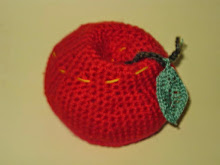This year I will crochet the cone.....I will post this work asap.
** Begin with flat "fibonacci ripples" to 89 stitches......mathematical modelling diagram will follow...
------------------------------------------
*** the cone on the card is 6.5 cm diameter, height 15 cm.
Happy Christmas !
----------------------------------------
The idea is that when a Crochet Pattern for Cones is determined, then I can work on a Spiral Cone and this will continue on in a study of the tops (spires) of SEASHELLS, some of which are very pointy indeed, even with height 9 x the base opening area.
----------------------------------------------
21/12/2014 more:-
It is made. Base 89 then 55 then 34 then 21 then 13 etc.
Maybe I shall decorate it with beads, make a trunk and stand....
next year....
Pattern to follow......
I am busy fixing my caravan so that snakes can't get in after the mice! That's why no proper posts for a while.
_______________________________________
27/12/2014 more:-
Click on image to see it more clearly.
Pattern for Model.
The circle underneath begins with a chain of 6 loops.
Join with a slip stitch and then do the first crochet stitch into the same loop.
Keep a strand of different colour wool to indicate end of each circular row.
Next row increase to 11. (make 1 row. ie 3 minus2)
Then increase to 21, (make 2 rows of 21. ie 5 -3)
then 34; (4 rows; ie 9 - 5))
Increase to 55; (5 rows; ie 14 - 9)
ie. circumference 55 has radius 14 units, radius 34 has 9 units; distance between is 5 units.
(If you were to continue on this way, as the following Table shows, of increasing radii and circumferences , then you would make a Model of Fibonacci Ripples.)
I used single crochet stitch, hook size 2.5, green 4 ply equivalent cotton,
tho you might get better results with finer cotton or wool...
and you can use any stitch or size hook.
Increase to 89. This is the base edge.
Then I did a dark green row tho you might like to differ.
make 14 rows of 89 stitches.
Decrease to 55; then dark green and do 9 rows of 55.
Decrease to 34; then dark green row; 6 rows of 34.
Decrease to 21; then dark green, 3 rows of 21.
Decrease to 13 which has 2 rows
Decrease to 8, then 5, do it however way your work needs to make the pointy tip
= not so easy- might need to use finer hook for the tip.
You need to begin to pad the model at the end of the 21 stitch rows.
I was lucky to have some combed wool fleece.
(27/12/2014- I have made some corrections to the above at 11:16 PM at night.)
** I forgot to say to make a cardboard circle to line the base before you put in padding.
I could make a shorter model
eg to make a model 14 units tall
see diagram Variations in size of Fibonacci Cones on this page.
which is IAW the actual radius for a circle of 89 units' circumference.
***There is crochet information in the next post.
US terms are different from UK, EU and Aust Crochet.****
Here is the Table for Fibonacci numbers. Circumferences and corresponding radii.
You can see that each radius is almost 1/10 of the next circumference in the Table -----
actually here are 2 Tables intertwined --- the Fibonacci Series and the 1/2 Fibonacci series.
-------------------------------
One can figure out any cone size, short or tall. Pythagoras theorem.
Important to keep all in proportion.
Some seashells, eg augers, may have height 9 x the base width.
Diagram: Variations in Fibonacci Cone Sizes.
Please click on image to enlarge it.
Please click on images to increase size.
Cardboard Model.One of these is correct = right hand spiral.
The Cone is made.
Spiral is drawn up the sides.
This may describe the spires of seashells....
one snips along the spiral line.....
This is the kind of shape I need to achieve when crocheting the tops of seashells.
I have measured inside and outside edges, using 1 cm caliper distance.
A young silky oak tree
along Burrangong Creek, Young.
It shows classical shape.
click on image to see more clearly- origins of
christmas tree may have been Martin Luther, or it may have been in Riga. Latvia.....
info from Facebook news feed.
------------------------------------



















No comments:
Post a Comment